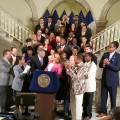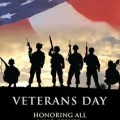Depending on your point of view, veteran homelessness may be eliminated within a few months but the housing dilemma is what will continue for, perhaps, many years to come. You see, the Mayor’s Office states there are an estimated 1,000 veterans or less that are Homeless in New York City. 97% of those veterans are split between Veteran Affairs (VA) sponsored shelters and shelters run by the Department of Homeless Services (DHS) while the remaining 3% are on the streets. This is an accomplishment that has been praised by the White House and brings NYC to a realistic goal to ending Veteran homelessness by the end of 2015.
This triumph for NYC began when President Obama took office in 2009 along with the VA establishing a deadline for the end of 2015. Afterwards, a trend started with the percentage of veteran homelessness decreasing across the nation at record breaking numbers. In the middle of 2014, Michelle Obama took it a step further by challenging mayors and elected officials from across the country to exemplify this endeavor. Subsequently, in the beginning of this year, Mayor de Blasio stated he accepted this challenge and had a plan towards completing the goal by the end of the year.
Now if you believe in the statistics from the Mayors Office, it is realistic that in a few months the 30 or so homeless veterans not in shelters will receive some degree of services. But, lets focus on the estimated 970 veterans in the shelters; they are currently in programs to help them seek transitional or permanent housing. The type of services they receive is dependent on many factors such as time in service, service era, combatant, if family or single occupancy is needed, disability, and so on. Their time frames in the shelter system vary as well; those that have priority or seniority will leave and open spaces for others. If we house 3% – 5% by the end of December then that leaves room for the ones currently on the streets or for any excess that might occur.
How do you get veterans out of the shelter? That is the city’s true problem.
The VA in cooperation with the Department of Housing and Urban Development – Veteran Affairs Supportive Housing (HUD VASH) program provides a limited amount of vouchers to veterans for rent assistance. HUD VASH is the veteran equivalent of the Section 8 housing program. There are also non-profit organizations that can also help as they build housing complexes and provide supportive housing to veterans at low cost. The other programs rely on supportive services such as employment, disability claims, and public assistance.
Now this brings in two different scenarios for the estimated 970 veterans in the shelter system, but let’s focus on the ones with seniority and priority members.
Scenario 1: Since a limited number of HUD VASH vouchers are given out per year and limited vacancies are available in a complex, a portion may currently be in the process of assignment or already allocated. This scenario could easily cover 5% of the sheltered veterans or leaves the process at a standstill but not individuals for processing.
Scenario 2: The 5% or so that depart from the shelters leave and open space for the unsheltered veterans. Once the New Year begins, the veterans that are processed by counselors can enroll into the new vouchers and, if new complexes are built, transition into them. That leaves another 5% of sheltered veterans or more that could be assisted in the first quarter alone or a solid plan for an estimated time frame.
Unfortunately, with the uproar of vagrancy running high across the city in the last few months it is hard to believe these statistics are even realistic. Recently, the NYC Police Department – Sergeants Benevolent Association (SBA) have been posting photos on their blog of destitute individuals on the street as well as beginning a crack down on encampment sites. Due to this, there has been an enormous outcry from many veteran organizations requesting to meet Mayor de Blasio to talk about the topic at hand but, so far, their requests have been ignored.
More peculiar is the timeline the Mayors Office for Veteran Affairs (MOVA) and the DHS issued vacancy announcements for their new Veteran Coordinators positions. These positions will be the “frontline” counselors for the veteran homeless population; it was only posted seven months into the year. With the goal so close at hand, why wasn’t it introduce sooner? The funding has been in place for over a year but delaying it seems to believe that the city is confident they will keep their promise.
But what else can the city do in its last stride? It needs the support from the community.
The following would bring clarity to the Mayor’s Office statistics, put advocates and organizations at the city’s disposal, and give private renters the knowledge of benefits afforded to veterans. I came up with these realistic and plausible goals:
- Complete two more citywide surveys of the veteran homeless population.
- Have three forums to educate the landlords, brokers and realtors on the different programs that are available to veterans.
- Have two citywide symposiums regarding the non-profits and private organizations (local/national) that would like to assist.
Soon we might eliminate the veteran homeless population in NYC and then all we need to do is worry about is the rest.
Gonzalo Duran is CEO of Devil Dog USA Incorporated, a non-profit in the Bronx that focuses on veterans. Duran is a Veteran Columnist for The Bronx Chronicle. For information or assistance, Gonzalo can be reached at Ceo@devildogusainc.org or (516) 515-0240.

















Follow Us